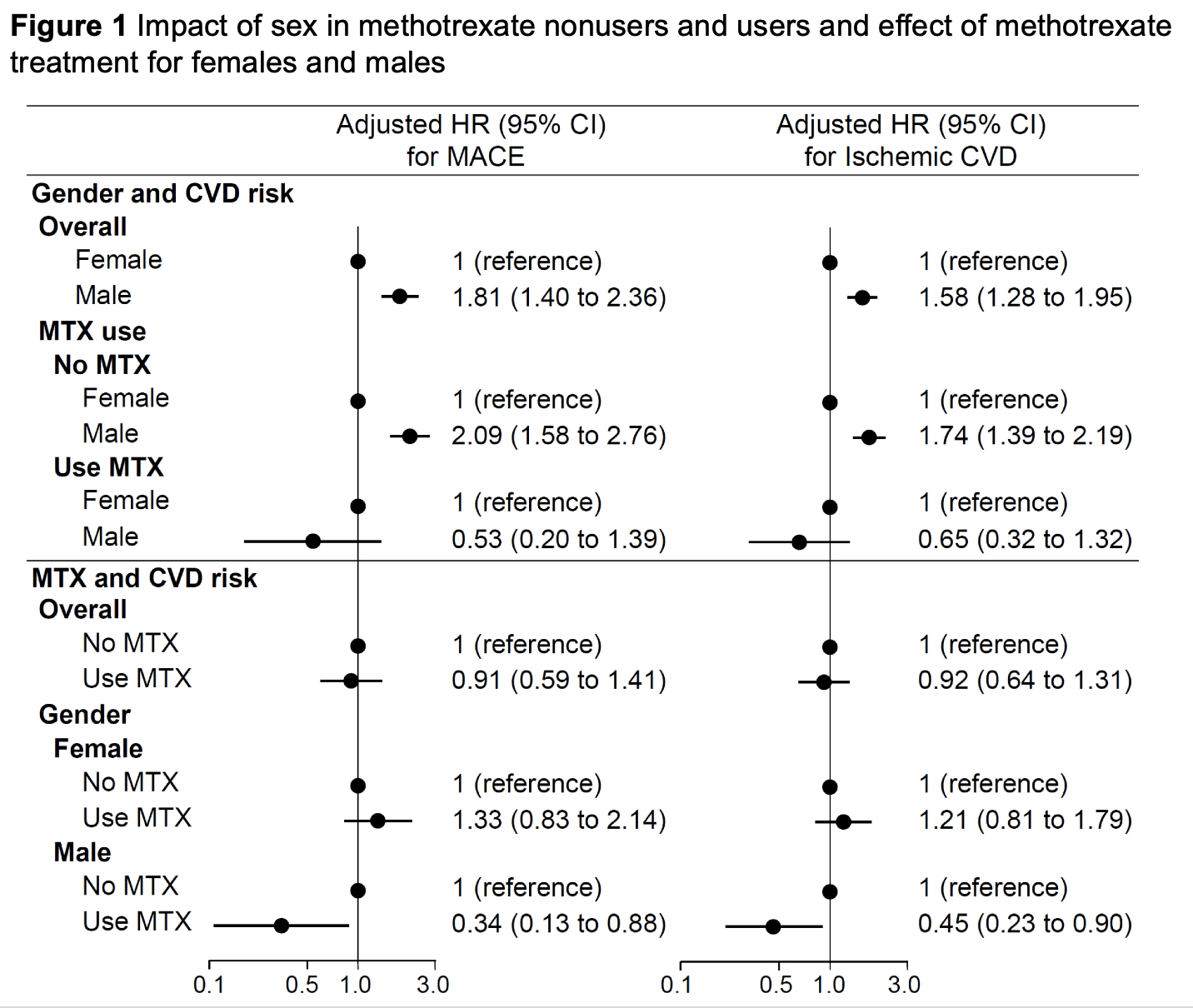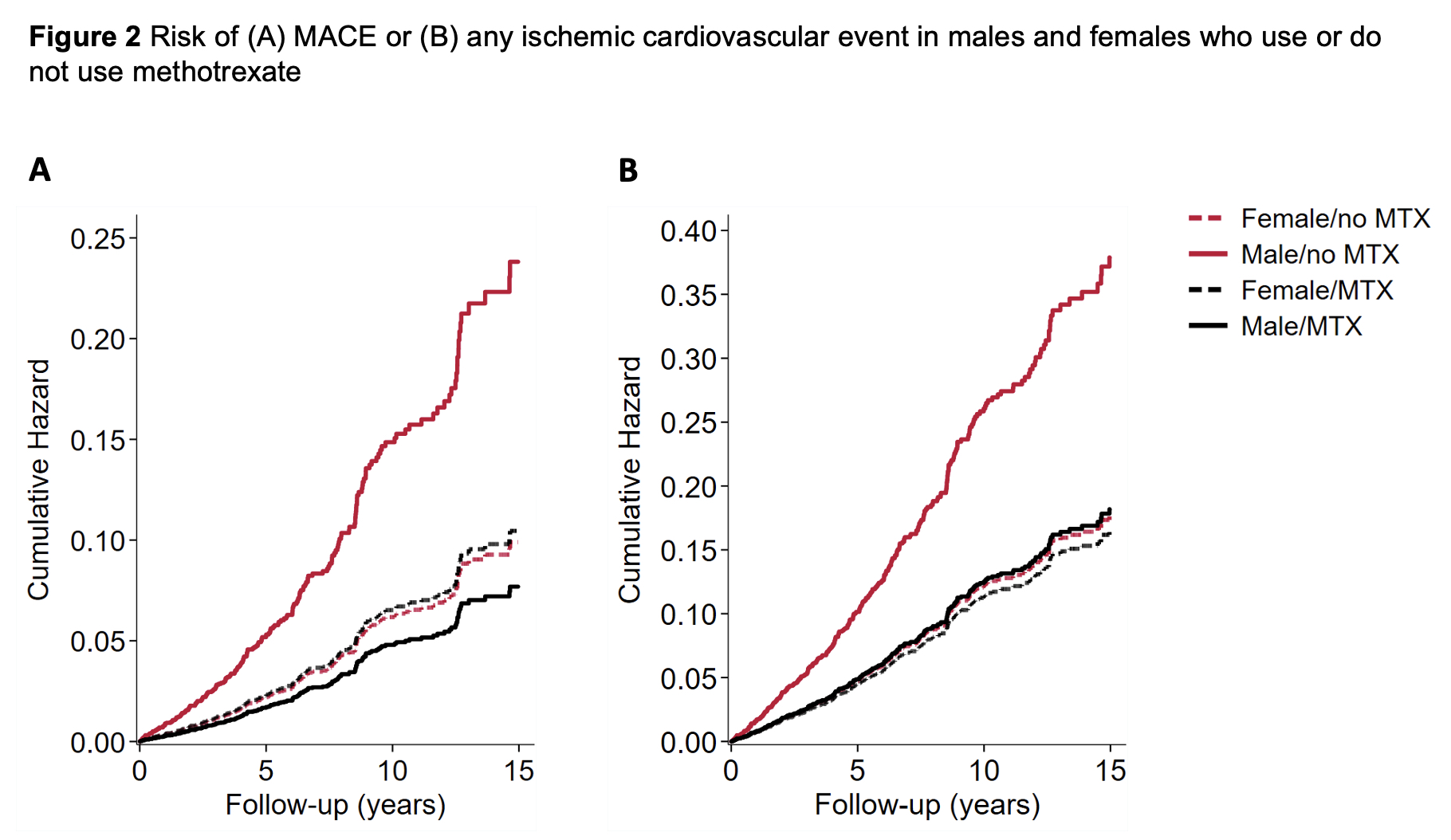Abstract Session
Rheumatoid arthritis (RA)
Session: Abstracts: RA – Diagnosis, Manifestations, & Outcomes II: Comorbidities (1627–1632)
1627: Methotrexate Use Associates with Ischemic Cardiovascular Risk Reduction in Males but Not Females with Rheumatoid Arthritis
Monday, November 13, 2023
2:00 PM - 2:10 PM PT
Location: Ballroom 20D

George Karpouzas, MD (he/him/his)
Harbor-UCLA Medical Center
Torrance, CA, United StatesDisclosure information not submitted.
Presenting Author(s)
George Karpouzas1, Sarah Ormseth2, Piet Van Riel3, Elena Myasoedova4, Miguel A Gonzalez-Gay5, Alfonso Corrales6, Solbritt Rantapää-Dahlqvist7, Petros Sfikakis8, Patrick Dessein9, Linda Tsang9, Carol Hitchon10, Hani El Gabalawi10, Virginia Pascual Ramos11, Irazú Contreras Yañez12, Iris Colunga13, Dionicio A. Galarza-Delgado13, José Ramón Azpiri-López13, Silvia Rolefstad14, Anne Grete Semb15, Durga P Misra16, GEORGE KITAS17 and Ellen Margrethe Hauge18, 1Harbor-UCLA Medical Center, Torrance, CA, 2The Lundquist Institute, Torrance, CA, 3Radboud University Medical Center, Drunen, Netherlands, 4Mayo Clinic, Rochester, MN, 5IDIVAL and School of Medicine, UC, Santander; Department of Rheumatology, IIS-Fundación Jiménez Díaz, Madrid, Santander, Spain, 6Rheumatology Department, Immunopathology Group, Hospital Universitario Marqués de Valdecilla-IDIVAL, Santander, Spain, 7Department of Public Health and Clinical Medicine/Rheumatology, Umeå University, Umeå, Sweden, 8National Kapodistrian University of Athens Medical School, Athens, Greece, 9University of Witwatersrand, Johannesburg, South Africa, 10University of Manitoba, Winnipeg, MB, Canada, 11Instituto Nacional de Ciencias Medicas y Nutricion Salvador Zubiran, Mexico City, Mexico, 12Instituto Nacional de Ciencias Médicas y Nutrición Salvador Zubirán, Mexico City, Mexico, 13Hospital Universitario UANL, Monterrey, Mexico, 14Diakonhjemmet Hospital, Oslo, Norway,, Oslo, Norway, 15Preventive Cardio-Rheuma clinic, Dept Rheum, Diakonhjemmet Hospital, Oslo, Norway, 16Sanjay Gandhi Postgraduate Institute of Medical Sciences (SGPGIMS), Lucknow, India, 17The Dudley Group NHS Foundation Trust, Birmingham, United Kingdom, 18Aarhus University Hospital, Aarhus, Denmark
Background/Purpose: Patients with rheumatoid arthritis (RA) experience higher cardiovascular risk compared to non-inflammatory disease controls. Methotrexate (MTX) may decrease cardiovascular risk in patients with RA. It is, however, unclear whether sex differentially impacts cardiovascular risk in MTX users and non-users and whether men and women derive equal benefit from methotrexate use. We here explored the influence of sex on cardiovascular risk in MTX nonusers and users. We further evaluated the effect of MTX treatment on cardiovascular risk in males and females with RA.
Methods: We evaluated 4362 patients and no cardiovascular disease prospectively included in an observational cohort [An International Cardiovascular Consortium for people with RA (ATACC-RA)]. Outcomes were (a) major adverse cardiovascular events (MACE) defined as cardiovascular death, non-fatal myocardial infarction or stroke and (b) any ischemic cardiovascular events (CVE) including MACE, stable angina, coronary revascularization, transient ischemic attack and peripheral arterial disease with or without revascularization. Missing data were imputed using multiple imputation with 10 repetitions. Multivariable Cox models stratified by center evaluated the impact of sex, baseline MTX use and their interaction on event risk after adjusting for age, hypertension, diabetes, family history, smoking, total cholesterol to high-density lipoprotein cholesterol ratio, disease duration, and activity score (DAS28 ESR). Two sensitivity analyses were conducted; The first used inverse probability of treatment weights to balance differences in MTX treated and untreated patients. The second included patients enrolled in the cohort on or after January 1, 2000, when MTX use became more prevalent.
Results: There were 237 first MACE and 358 total ischemic CVE during follow-up. Male sex associated with an 81% and 58% greater risk of MACE and any ischemic CVE respectively (Figure 1). Among MTX nonusers, incidence of MACE and any ischemic CVE was higher in males [17.6 (95% CI 14.4-21.3) and 24.5 (20.7-28.9) events/1000PY] compared to females [6.9 (5.7-8.4) and 11.4 (9.8-13.3) events/1000PY, all p for difference < 0.001]. In adjusted Cox models, male nonusers had a 2.09-fold and 74% higher risk of MACE and any ischemic CVE compared to female nonusers (both p< 0.001, Figures 1 and 2). In contrast, among users, incidence of MACE and any ischemic CVE was not different in males [4.2 (1.7-10.0) and 7.6 (4.0-14.6) events/1000PY] versus females [6.4 (4.4-9.2) and 9.4 (6.9-12.8) events/1000PY] and sex was not associated with event risk in MTX users. Among males, MTX use associated with a 66% and 55% lower risk of MACE and any ischemic CVE (p=0.026 and 0.024). In contrast, MTX use was not associated with MACE or any ischemic CVE in females [adjusted HR 1.33 (0.83-2.14) and 1.21 (0.81-1.79)]. Both sensitivity analyses yielded similar results.
Conclusion: RA males not using MTX exhibit higher risk of MACE and any ischemic CVE compared to female nonusers, while no differences were observed between male and female users. Baseline MTX use associated with lower risk of MACE and all ischemic CVE in males but not females.


G. Karpouzas: Janssen, 1, Pfizer, 5, Scipher, 1; S. Ormseth: None; P. Van Riel: None; E. Myasoedova: None; M. Gonzalez-Gay: AbbVie/Abbott, 5, 6, Amgen, 5, 6, Pfizer, 5, 6; A. Corrales: None; S. Rantapää-Dahlqvist: None; P. Sfikakis: AbbVie/Abbott, 2, 5, Amgen, 2, 5, Boehringer-Ingelheim, 2, 5, Celgene, 2, 5, Eli Lilly, 2, 5, Janssen, 2, 5, Novartis, 2, 5, Pfizer, 2, 5; P. Dessein: None; L. Tsang: None; C. Hitchon: Astra Zeneca, 1, Pfizer, 5; H. El Gabalawi: None; V. Pascual Ramos: None; I. Contreras Yañez: None; I. Colunga: None; D. Galarza-Delgado: None; J. Azpiri-López: None; S. Rolefstad: None; A. Semb: None; D. Misra: None; G. KITAS: None; E. Hauge: AbbVie/Abbott, 5, 6, Galapagos, 5, Novartis, 6, Novo Nordic Foundation, 5, 6, Sanofi, 6, Sobi, 6.
Background/Purpose: Patients with rheumatoid arthritis (RA) experience higher cardiovascular risk compared to non-inflammatory disease controls. Methotrexate (MTX) may decrease cardiovascular risk in patients with RA. It is, however, unclear whether sex differentially impacts cardiovascular risk in MTX users and non-users and whether men and women derive equal benefit from methotrexate use. We here explored the influence of sex on cardiovascular risk in MTX nonusers and users. We further evaluated the effect of MTX treatment on cardiovascular risk in males and females with RA.
Methods: We evaluated 4362 patients and no cardiovascular disease prospectively included in an observational cohort [An International Cardiovascular Consortium for people with RA (ATACC-RA)]. Outcomes were (a) major adverse cardiovascular events (MACE) defined as cardiovascular death, non-fatal myocardial infarction or stroke and (b) any ischemic cardiovascular events (CVE) including MACE, stable angina, coronary revascularization, transient ischemic attack and peripheral arterial disease with or without revascularization. Missing data were imputed using multiple imputation with 10 repetitions. Multivariable Cox models stratified by center evaluated the impact of sex, baseline MTX use and their interaction on event risk after adjusting for age, hypertension, diabetes, family history, smoking, total cholesterol to high-density lipoprotein cholesterol ratio, disease duration, and activity score (DAS28 ESR). Two sensitivity analyses were conducted; The first used inverse probability of treatment weights to balance differences in MTX treated and untreated patients. The second included patients enrolled in the cohort on or after January 1, 2000, when MTX use became more prevalent.
Results: There were 237 first MACE and 358 total ischemic CVE during follow-up. Male sex associated with an 81% and 58% greater risk of MACE and any ischemic CVE respectively (Figure 1). Among MTX nonusers, incidence of MACE and any ischemic CVE was higher in males [17.6 (95% CI 14.4-21.3) and 24.5 (20.7-28.9) events/1000PY] compared to females [6.9 (5.7-8.4) and 11.4 (9.8-13.3) events/1000PY, all p for difference < 0.001]. In adjusted Cox models, male nonusers had a 2.09-fold and 74% higher risk of MACE and any ischemic CVE compared to female nonusers (both p< 0.001, Figures 1 and 2). In contrast, among users, incidence of MACE and any ischemic CVE was not different in males [4.2 (1.7-10.0) and 7.6 (4.0-14.6) events/1000PY] versus females [6.4 (4.4-9.2) and 9.4 (6.9-12.8) events/1000PY] and sex was not associated with event risk in MTX users. Among males, MTX use associated with a 66% and 55% lower risk of MACE and any ischemic CVE (p=0.026 and 0.024). In contrast, MTX use was not associated with MACE or any ischemic CVE in females [adjusted HR 1.33 (0.83-2.14) and 1.21 (0.81-1.79)]. Both sensitivity analyses yielded similar results.
Conclusion: RA males not using MTX exhibit higher risk of MACE and any ischemic CVE compared to female nonusers, while no differences were observed between male and female users. Baseline MTX use associated with lower risk of MACE and all ischemic CVE in males but not females.


G. Karpouzas: Janssen, 1, Pfizer, 5, Scipher, 1; S. Ormseth: None; P. Van Riel: None; E. Myasoedova: None; M. Gonzalez-Gay: AbbVie/Abbott, 5, 6, Amgen, 5, 6, Pfizer, 5, 6; A. Corrales: None; S. Rantapää-Dahlqvist: None; P. Sfikakis: AbbVie/Abbott, 2, 5, Amgen, 2, 5, Boehringer-Ingelheim, 2, 5, Celgene, 2, 5, Eli Lilly, 2, 5, Janssen, 2, 5, Novartis, 2, 5, Pfizer, 2, 5; P. Dessein: None; L. Tsang: None; C. Hitchon: Astra Zeneca, 1, Pfizer, 5; H. El Gabalawi: None; V. Pascual Ramos: None; I. Contreras Yañez: None; I. Colunga: None; D. Galarza-Delgado: None; J. Azpiri-López: None; S. Rolefstad: None; A. Semb: None; D. Misra: None; G. KITAS: None; E. Hauge: AbbVie/Abbott, 5, 6, Galapagos, 5, Novartis, 6, Novo Nordic Foundation, 5, 6, Sanofi, 6, Sobi, 6.



